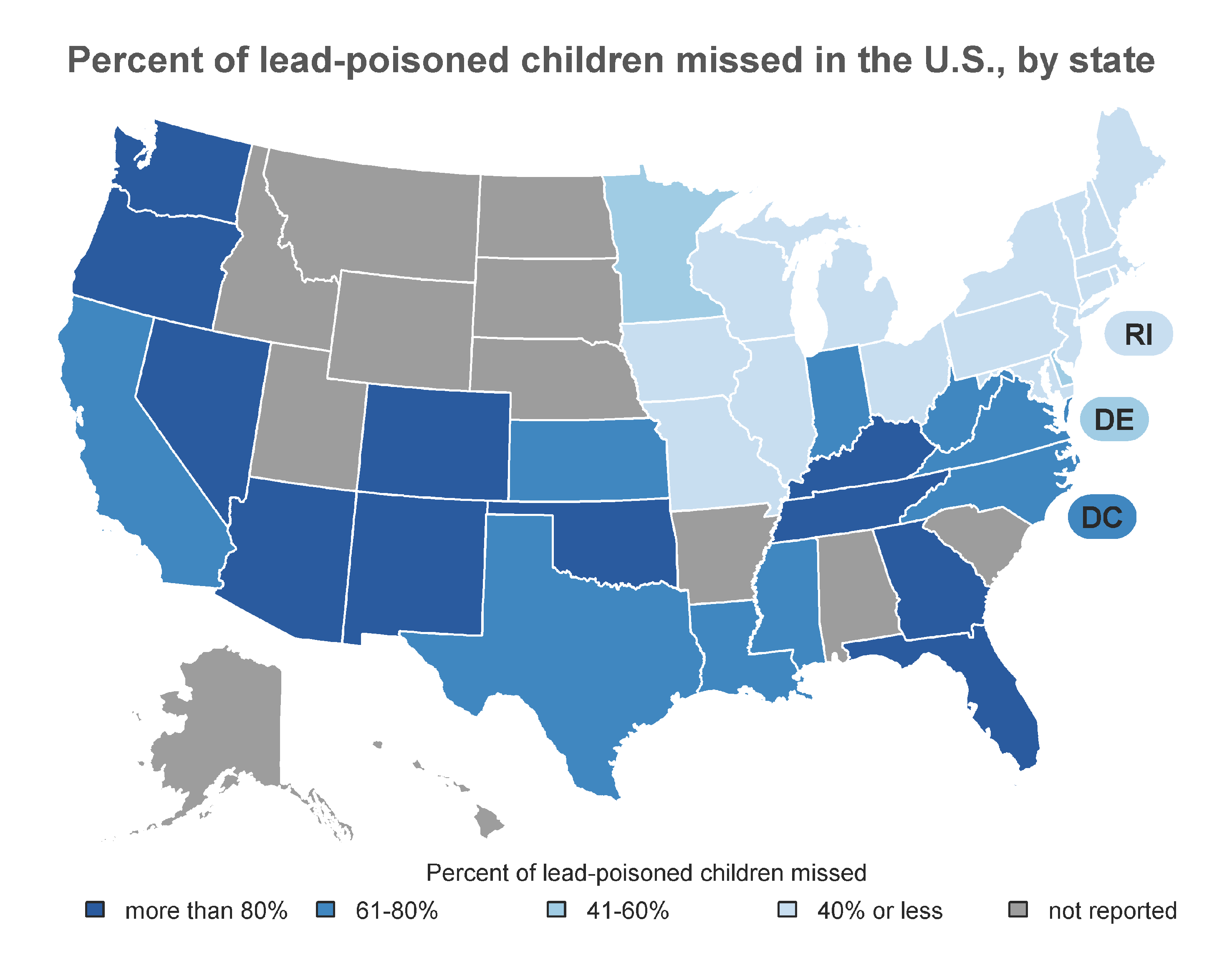
In the News
1.2 million children in the US have lead poisoning. We’re only treating half of them.
-
Focus Areas
Environmental Health, Healthy Communities -
Expertise
Research – Surveillance -
Programs
Tracking California

Several states are doing an abysmal job of testing at-risk children for lead poisoning.
We’ve long known that despite all our efforts to clean up lead, we have a serious problem with lead poisoning in American children — it’s an egregious and preventable public health issue that just won’t go away.
And it seems the problem is even worse than we thought. Researchers at the Public Health Institute reported Thursday in the journal Pediatrics that the overall number of children with elevated blood lead levels as of 1999-2000 in the US was 1.2 million, or double what the Centers for Disease Control and Prevention had reported. (The number is likely even higher now, since testing rates have only declined since 2000.) These kids who are never tested or reported to the CDC also aren’t receiving treatment.
Some states are doing much worse than others, according to the researchers. In the 11 states in dark blue on the map below, including Arizona and Florida, more than 80 percent of children with lead poisoning were not tested by their pediatricians or local health departments. For the other 28 states with data (in medium and light blue), anywhere from 40 to 60 percent of lead-poisoned children weren’t tested.
As for the 12 states in gray, researchers were unable to determine how many cases of lead poisoning were missed, because these states don’t share any data with the CDC.
So how are we failing to account for so many lead-poisoned children?
The answer (as well as the solution) is pretty straightforward. We don’t test enough children for lead, and as a result, lead poisoning cases in the US go undetected. If doctors were to test more children and if states were to mandate testing for more at-risk populations, then more children suffering from lead poisoning would get the treatment they so desperately need. It might also mean we’d get more serious about dealing with the threat of lead itself.
Testing for lead isn’t required in the US — and so doctors miss children exposed to the toxin
In 1984, 17 percent of all American preschool children had blood lead levels that exceeded 15 micrograms per deciliter, or μg/dL. But thanks to the ban of leaded paint in 1978 and the gradual phaseout of leaded gasoline in the mid-1970s, BLLs in preschool children have continued to decline overall, so that in 2014 just 0.53 percent of children tested in the US had elevated BLLs of 10 μg/dL or greater — once a threshold for the harmful effects of lead.
What researchers have learned in recent years is that no level of lead is safe for children. Studies have even shown lead concentration in the blood as low as 2 micrograms per deciliter of blood (μg/dL) can lower IQ in children. And once children have blood lead levels of 5 μg/dL and above (what’s now considered lead poisoning), they can suffer severe neurological damage in the form of attention deficit and hyperactivity disorders.
In 2014, the CDC found that 4.2 percent of children test, or half a million, had elevated blood lead levels of 5 (μg/dL) or greater. But Eric Roberts, the lead author of the new paper in Pediatrics, and colleagues suspected this number was incomplete.
“People talk about the great public health victory over lead, which is true, but I think it kind of blinded us,” he said.
To calculate how many lead poisoning cases in the US might be unreported, Roberts and his colleagues used the CDC’s National Health and Nutrition Examination Survey (NHANES). They also used census data on housing, race, poverty, and region of residence (all known risk factors of lead exposure) to determine rates of lead poisoning. The researchers then compared their numbers with the CDC’s reported confirmed lead poisoning cases and found that nearly 600,00 children suffering from lead poisoning (blood lead levels 10 μg/dL or greater) were not counted. And this is a conservative estimate because the CDC’s threshold for lead poisoning is now 5 μg/dL.
How did the counting of lead-poisoned children get so bad? For one, testing for lead is not legally required in most of the US. (Technically, the most vulnerable children, such as Medicaid beneficiaries, are required to be tested, but a 2016 Reuters investigation in nearly a dozen states found that only 41 percent of 1- and-2-year-old Medicaid enrollees had been tested.)
And, Roberts says, public health departments aren’t asking if there’s missing data when they turn things over to the CDC.
“State departments report the number of [lead poisoning] cases to folks who ask, but that doesn’t get at the question of whether there is missed data,” he said. “They’re just reproducing what the pediatricians did. So you can imagine where states fall into a vicious circle — pediatricians don’t look for [lead poisoning], public health departments tell them there is no problem, and so they continue not to look for it.”
70 percent of lead-poisoned children go untested and untreated in the Southern and Western US
There is wild variation in the US when it comes to assessing the risk of lead poisoning in communities and testing children. And as you can see in the chart below, states in the South and West aren’t testing very many children at all.
/cdn0.vox-cdn.com/uploads/chorus_asset/file/8414623/Screen_Shot_2017_04_26_at_3.58.23_PM.png)
In five states in the American West — Washington, Nevada, New Mexico, Colorado, and Oregon — only one in 10 children were treated for lead poisoning.
Studies have largely focused on lead poisoning from old housing stock in the US (built before 1950), which is most highly concentrated in the Northeast and Midwest. It’s one of the reasons these two regions have such high levels of reporting. But as Roberts told Vox, his study “busts this balloon that its just a Northeast and Midwest problem,” and shows there is risk of lead exposure everywhere in the US.
“What the model seems to be telling us is the greatest number of lead poisoning cases are actually in the South, and there are big numbers in the West too,” he said.
America’s infrastructure literally makes children sick
Water doesn’t naturally contain much lead. The problem is with the pipes. Prior to 1980, most US drinking water systems contained lead service lines. Today there are an estimated 6 million lead pipes still in operation, servicing at least 10 million Americans.
And now many of these systems are in desperate need of repair.
Public schools in Portland, Oregon, shut off their drinking water taps last summer after high levels of lead were found across the school district’s water fountains. A school in western Pennsylvania was sued for letting high levels of lead in the drinking water go untreated for months. And a USA Today investigation found 2,000 public water systemsacross the US with elevated lead levels that exceeded the Environmental Protection Agency limit of 15 parts per billion — 350 of which serviced elementary schools or day cares.
“What we’re figuring out now in the public health community is you have this deteriorating infrastructure, which makes the lead poisoning problem suddenly rise, and no one would have known if they weren’t monitoring,” said Roberts.
Continue reading the full article in Vox.
The study was also picked up by several other media outlets:
- Children with elevated lead levels aren’t being tested or diagnosed, study says – CNN
- Way more kids than we thought have lead poisoning. – Grist
- Study Shows a Third of Childhood Lead Poisoning Goes Undiagnosed – ColorLines Magazine
- Most US children with elevated blood lead go undetected, untreated – MDalert
- There May Be A Lot More Lead-Poisoned Kids Than Official Stats Show – Vocativ
- Study Finds Lead Poisoning In Kids Might Be Worse Than We Thought, & Here’s What That Means – Romper
- One-Third Of US Childhood Lead Poisoning Is Undiagnosed – Tech Times
- Report: More than 9 in 10 Colorado children with elevated lead levels go undiagnosed – ABC 7 / The Denver Channel
- PA 6th in number of lead-poisoned children – The Pittsburgh Tribune-Review
- Pediatricians Missing Elevated Blood Lead Levels in U.S. – HealthDay Physician’s Briefing
Originally published by Vox
More Updates
Work With Us
You change the world. We do the rest. Explore fiscal sponsorship at PHI.
Support Us
Together, we can accelerate our response to public health’s most critical issues.
Find Employment
Begin your career at the Public Health Institute.




